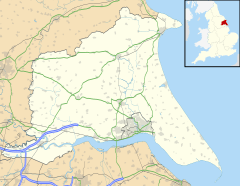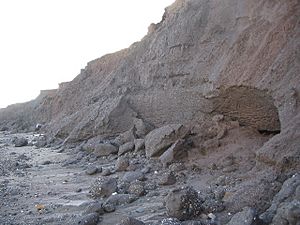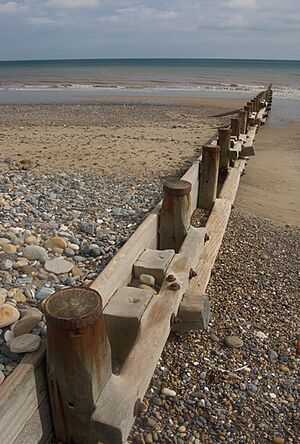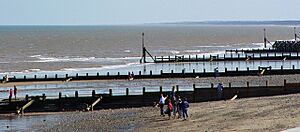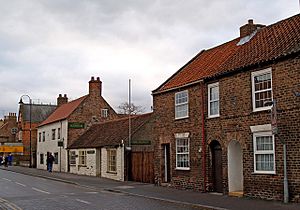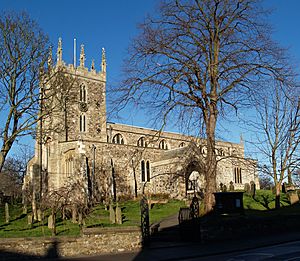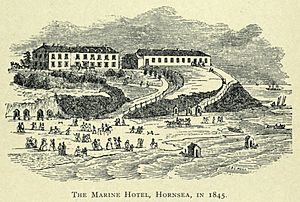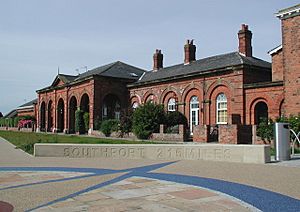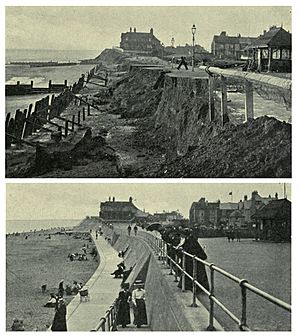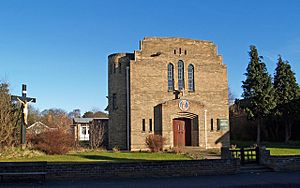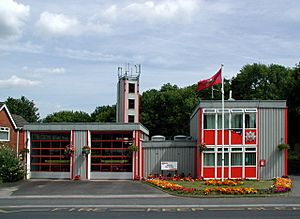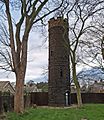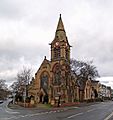Hornsea facts for kids
Quick facts for kids Hornsea |
|
|---|---|
| Town and civil parish | |
 Hornsea Promenade |
|
| Area | 4.61 sq mi (11.9 km2) |
| Population | 8,432 (2011 census) |
| • Density | 1,829/sq mi (706/km2) |
| OS grid reference | TA203476 |
| Civil parish |
|
| Unitary authority | |
| Ceremonial county | |
| Region | |
| Country | England |
| Sovereign state | United Kingdom |
| Post town | HORNSEA |
| Postcode district | HU18 |
| Dialling code | 01964 |
| Police | Humberside |
| Fire | Humberside |
| Ambulance | Yorkshire |
| EU Parliament | Yorkshire and the Humber |
| UK Parliament |
|
Hornsea is a fun seaside town and parish in the East Riding of Yorkshire, England. People have lived here since at least the early medieval period. The town grew a lot during the Victorian era when the Hull and Hornsea Railway arrived in 1864.
During the First World War, Hornsea Mere (a large lake) was briefly home to RNAS Hornsea Mere, a base for seaplanes. In the Second World War, the town and beach were made very strong to protect against invasion.
The Hornsea area includes the town itself, the natural lake called Hornsea Mere, and some old villages that are now lost, like Hornsea Beck, Northorpe and Southorpe. Important places to see include the old St Nicholas church, Bettison's Folly, Hornsea Mere, and the lovely seafront promenade.
Hornsea's economy relies on tourism and small factories. A famous company, Hornsea Pottery, started here in 1949 but closed in 2000. Today, Hornsea is still a popular coastal resort with big caravan parks nearby.
Because the soil is soft and the land is low, the coast here is always wearing away. This is called coastal erosion. It's expected to get worse as climate change causes sea level rise. In some places, people have already had to move their homes further inland.
Contents
What's in a Name?
The name Hornsea probably comes from old Norse words. Horn means "horn," nes means "headland" or "point of land," and sæ means "sea" or "lake." So, it might mean "horn-shaped headland by the sea/lake."
Exploring Hornsea's Geography
Hornsea is located on the Holderness coast, about 25 kilometers (15 miles) north-east of Hull. The area is surrounded by other small towns and villages, with the North Sea to the east. The parish includes Hornsea town, a small area called "Hornsea Bridge" or "Hornsea Burton," and Hornsea Mere. Most of the land is low-lying farmland.
Most of Hornsea is between 10 and 20 meters (33 and 66 feet) above sea level. The highest spots are less than 30 meters (98 feet) high. Main roads like the B1242 and A1035 help people travel around. There's also a path for walking and cycling called the Hornsea Rail Trail, which is part of the Trans Pennine Trail.
Hornsea Mere is a lake about 2 kilometers (1.2 miles) long and 1 kilometer (0.6 miles) wide. Water flows from it into the sea through a drain called Stream Dike Drain.
In 2011, Hornsea parish had a population of 8,432 people. Hornsea is part of the Beverley and Holderness area for Parliament.
Land and Sea: Erosion
The ground under Hornsea is mostly made of boulder clay. This is a type of clay with rocks in it, left behind by glaciers. The topsoil is fine and loamy. Deeper down, there's a type of rock called Flamborough Chalk.
Long ago, some people thought the land here showed signs of an earthquake or a great flood. But since the late 1800s, scientists have understood that the land was shaped by glacial processes (ice ages).
The coast at Hornsea is always changing due to erosion. In the past, the sea could wear away up to 6 yards (5.5 meters) of land each year! Today, the rate of erosion is slower in some places because of sea defenses like groynes (structures built into the sea to stop sand from moving away).
An old saying about Hornsea talks about how much the sea has moved closer:
Hornsea steeple, when I built thee,
Thou was 10 miles off Burlington,
10 miles off Beverley, and 10 miles off sea.—anon
This poem is a bit of an exaggeration, but it shows how much the coastline has changed over time!
Hornsea Town Today
The older part of Hornsea is around the Market Place. This area includes streets like Southgate, Westgate, and Mere Side. The newer resort area, with its promenade, is connected to the old town by Newbegin and New Road. Many buildings are made of red brick with tiled roofs, and some even use local cobbles (round stones).
Modern Hornsea also has several caravan sites, mostly on the edges of town. There are two nice parks: Hall Garth Park, which has an old moated site, and the Memorial Gardens.
Like other small seaside towns, Hornsea has a promenade, pretty gardens, hotels, fish and chip shops, and gift shops. On the southern side of Hornsea, you'll find Hornsea Freeport, a shopping center that used to be part of the original Hornsea Pottery theme park.
Hornsea has three schools: Hornsea Community Primary School, Hornsea Burton Primary School, and Hornsea School and Language College.
The town also has its own independent lifeboat service, called Hornsea Inshore Rescue, which is a charity.
You can easily get to and from Hornsea by bus. There are frequent services to Hull, Beverley, and Hessle, and a daily service to Bridlington and Withernsea.
Hornsea's Past: A Journey Through Time
From Ancient Times to the Middle Ages
People lived in the Hornsea area long, long ago. Signs of ancient human activity have been found, including a possible Stone Age (Neolithic) monument and tools from the Stone Age and Bronze Age.
There are also signs of human activity from the Iron Age and Roman Britain periods, which look like old field systems.
In 1913, an Anglo-Saxon burial ground was found near Cliff Road. More skeletons and many interesting items like vases, bronze, ivory, and silver objects were found there in 1982.
Hornsea is mentioned in the Domesday Book of 1086, a famous survey of England. After the Norman Conquest in 1066, the land eventually went to St Mary's Abbey, York, a Benedictine monastery. The Abbey also gained rights to fish in Hornsea Mere.
The beautiful Church of Saint Nicholas was built in the 1200s, with changes made in the 1300s and 1400s. It's made of cobbles and stone. The church tower used to have a tall spire, but it fell down in 1733. The church was greatly repaired in the 1860s.
In the Middle Ages, Hornsea was a market town and also a fishing port. Records show that many people lived in Hornsea and nearby villages like Hornsea Beck and Hornsea Burton.
Hornsea was once a port, meaning ships could come and go. There are old records from the 1200s talking about taxes on goods from ships. A pier (a long structure going into the sea) was built, but it was destroyed by the sea around the 1500s.
By the 1500s, Coastal erosion had made Hornsea less important as a port, but its market continued to be important for local people.
After the monasteries were closed down in the 1540s, ownership of Hornsea went back to the King.
There were windmills in Hornsea during the medieval period, used for grinding grain.
From the 1600s to the 1800s
By 1801, Hornsea's population was 533, and it steadily grew to 1,005 by 1841.
In 1732, a "hurricane" hit the town. It destroyed the church spire, damaged about 40 buildings, and even overturned a windmill!
Historically, buildings in Hornsea were made from brick or cobbles. Many old buildings made of these materials still stand today. The Old Hall in Hornsea Market Place dates back to the early 1600s.
Hornsea started to become a popular seaside resort around 1800. Early attractions included bathing machines (small huts on wheels for changing into swimsuits), horse races on the beach, and a special spring with healthy water. More facilities, like the first Marine Hotel, were built in the 1830s.
A railway line was planned for Hornsea in 1846, but it wasn't built then. In 1861, a new company was formed, and the Hull and Hornsea Railway opened in early 1864. Joseph Armitage Wade, a local businessman, was a key supporter of the railway. The Hornsea Railway Station, built in brick and sandstone, is still standing today. The new railway helped the resort grow and made it easier for people to live in Hornsea and work in Hull.
Fishing also grew in Hornsea before the railway. Many people became fishermen, catching mostly crabs. Crabbing continued until the 1930s.
With the railway came more development. New Road was built in 1848 to make it easier to reach the sea. Joseph Wade also built a brick and tile factory and developed new housing. Other new buildings included the Alexandra Hotel (1867) and Brampton House (1872–73).
The town also got better services, like a gas works (1864), improved drainage (1874–75), and a Waterworks (around 1878).
The seafront was also developed. The Marine Hotel was rebuilt several times, and gardens were added in 1898. The Imperial Hydro Hotel was built in 1914. Between 1878 and 1880, a long pier was built, but it was damaged by a ship and later sold for demolition.
Bettison's Folly, a tall tower, was built around 1844 by a local brewer named William Bettison. It has the only fully working retractable flagpole in the country!
By 1891, Hornsea's population had reached 2,013, growing to 2,381 by 1901.
The 1900s and Beyond
In the early 1900s, new areas of Hornsea grew near the railway station and along the seafront. The promenade and gardens (Victoria Gardens) were started in the 1890s. The 'Floral Hall' was added to the seafront gardens in 1913.
New sea defenses were built around 1907 after a big storm in 1906 damaged the coast. These defenses included groynes and a concrete sea wall to protect the seafront.
Other additions in the early 1900s included the Pickering Almshouses (built 1908) and a convalescent home. Hornsea Golf Course opened in 1910.
During the First World War, RNAS Hornsea Mere, a seaplane base, was built on Hornsea Mere to help patrol the North Sea for submarines. It was closed after the war.
By the 1920s, Hornsea continued to grow with new housing. A park was also built in the area known as Hall Garths.
Improvements between the World Wars included a new fire brigade building (1924), better sewers, and electricity supply (1930). In 1927, the local council turned Elim Lodge into Hornsea Town Hall.
During the Second World War, Hornsea was heavily fortified to stop any invasion. The beaches had pillboxes (small concrete bunkers) and anti-tank barriers. Roads and railways were blocked, and there were minefields to slow down any invading forces. Many of these structures are no longer there.
Hornsea's population kept growing throughout the 1900s. By 1951, it had reached 5,324.
Hornsea Pottery was started in 1949 and became a major employer, with 200 people working there by the 1960s. The Catholic Church of the Sacred Heart was built in 1956.
The railway line from Hull to Hornsea closed in 1964/65. This led to some decline in the town's tourist industry.
Later improvements in the 1900s included a new fire station (1965) and a new sewer system. Small industrial areas were also built.
A museum, The North Holderness Museum of Village Life (Hornsea Museum), opened in 1978. Hornsea Pottery closed in 2000, but a shopping center called 'Hornsea Freeport' opened at its old site in 1994. Hornsea also got a swimming pool at the 'Hornsea Leisure Centre' in 1996.
Hornsea in the 21st Century
In 2009, a large Tesco store was approved and opened in January 2012.
By 2011, Hornsea's population had grown to 8,432.
In 2012, a former Methodist chapel was turned into the new Hornsea Town Hall.
Lost Villages of Hornsea
Over time, some villages near Hornsea have been lost to the sea due to coastal erosion.
Hornsea Beck
53°54′57″N 0°09′25″W / 53.915889°N 0.156950°W Hornsea Beck was a small village right by the sea. It existed as early as 1367 but was completely destroyed by coastal erosion around 1747. Records show that 38 houses were lost to the sea between 1546 and 1609.
Hornsea Burton
Hornsea Burton was located south-east of Hornsea Town. The road that leads to the coast today used to go about half a mile further to Hornsea Burton village, which is now under the sea. By 1840, the remaining part of the village was empty.
Northorpe
53°55′29″N 0°10′47″W / 53.924763°N 0.179633°W Northorpe was a village north of Hornsea. It became completely empty sometime between the late 1600s and 1809.
Southorpe
53°54′00″N 0°11′07″W / 53.899910°N 0.185272°W Southorpe was a village on the south side of Hornsea Mere. It was mentioned in the Domesday survey and existed until the 1600s. By the early 1800s, the village was abandoned.
Images for kids
Sports in Hornsea
Hornsea is a great place for sports!
Hornsea Cricket Club plays at the Hollis Recreation Ground. Famous former players include Johnny Briggs (who played for England) and Tom Kohler-Cadmore (who plays for Worcestershire and Yorkshire).
Hornsea is also home to Hornsea Rugby Union Football Club, nicknamed the 'Hollismen'. They play at the Hollis Recreation Ground.
Hornsea Town F.C. is an amateur football team, also playing at the Hollis Recreation Ground. They are known as 'Town' or 'The Seasiders'. The club has several teams, including a first team, reserves, veterans, and a Sunday team.
Hornsea in the Media
You can get local news and TV shows from BBC Yorkshire and Lincolnshire and ITV Yorkshire.
Hornsea's local radio stations include BBC Radio Humberside, Hits Radio East Yorkshire & North Lincolnshire, Capital Yorkshire, Greatest Hits Radio East Yorkshire, Nation Radio East Yorkshire, and the community station Seaside FM.
The local newspapers are the Holderness and Hornsea Gazette and Hornsea Community News.
Famous People from Hornsea
Many interesting people have connections to Hornsea:
- Johnny Briggs (1862–1902), a former England cricketer who played at Hornsea CC.
- Edward John Eyre (1815–1901), an English explorer in Australia, whose father was a vicar in Hornsea.
- James Opie Urmson (1915-2012), a well-known philosopher, was born in Hornsea.
- Sonia Dresdel (1909–1976), an English actress, was born here.
- Winifred Holtby (1898–1935), a writer, lived on Cliff Road for a while.
- Sheila Mercier (1919–2019), an actress.
- Adrian Rawlins (born 1958), an actor, lives in Hornsea.
- Brian Rix (1924–2016), a famous actor, lived in Hornsea as a child.
- Joseph Sheard (1813–1883), who became the Mayor of Toronto, Canada, was born in Hornsea.
- Edith Tolkien (1889–1971), the wife of famous author J. R. R. Tolkien, stayed in Hornsea.
- Roger Lonsdale (1934–2022), a British literary scholar, was born in Hornsea.
See also
 In Spanish: Hornsea para niños
In Spanish: Hornsea para niños


